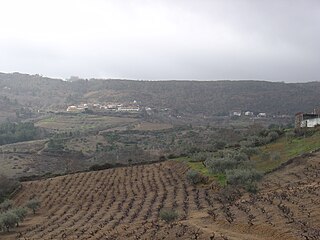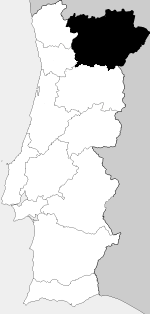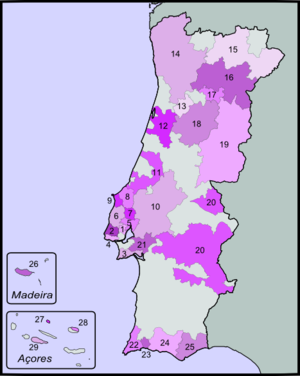Alcobaça is a Portuguese wine region centered on the town of Alcobaça in the Estremadura region. The region was initially an Indicação de Proveniencia Regulamentada (IPR) region, but in 2005 it became one of two subregions of the Encostas d'Aire DOC, which has Denominação de Origem Controlada (DOC) status. Its name may still be indicated together with that of Encostas d'Aire, as Encostas d'Aire-Alcobaça.
Alenquer is a Portuguese wine region centered on the town of Alenquer in the Lisboa wine region. The region is designated as Denominação de Origem Controlada (DOC) after it was promoted from its former Indicação de Proveniencia Regulamentada (IPR) status. Located in a valley in the district of Lisboa, wine grapes are able to ripen easily and produce full bodied red wines that have a spicy, peppery aroma. The white wines tend to be dry with a creamy mouthfeel.
Arruda is a Portuguese wine region centered on the town of Arruda dos Vinhos in the Lisboa wine region. The region is designated as Denominação de Origem Controlada (DOC) after it was promoted from its former Indicação de Proveniencia Regulamentada (IPR) status. The region is known primarily for its red wine production.
Biscoitos is a Portuguese wine region located on the Terceira island of the Azores. The region has the second tier Indicação de Proveniencia Regulamentada (IPR) classification and maybe some day promoted to Denominação de Origem Controlada (DOC). The production of the region is primarily fortified wines.
Castelo Rodrigo is a Portuguese wine region centered on the town of Figueira de Castelo Rodrigo in the wider Beiras wine region south of the Douro river. Castelo Rodrigo was initially a separate Indicação de Proveniencia Regulamentada (IPR) region, but in 2005, it became one of three subregions of the Beira Interior DOC, which has the higher Denominação de Origem Controlada (DOC) status. Its name may still be indicated together with that of Beira Interior, as Beira Interior-Castelo Rodrigo.

Chaves is a Portuguese wine region centered on the town of Chaves in the Trás-os-Montes e Alto Douro region. The region was initially a separate Indicação de Proveniencia Regulamentada (IPR) region, but in 2006, it became one of three subregions of the Trás-os-Montes DOC, which has the higher Denominação de Origem Controlada (DOC) status. Its name may still be indicated together with that of Trás-os-Montes, as Trás-os-Montes-Chaves.

Encostas d'Aire is a Portuguese wine region located on the limestone hills extending across the northern end of the wider Lisboa wine region into the southwestern corner of the Beiras region. The region was initially an Indicação de Proveniencia Regulamentada (IPR) region, but in 2005, it was elevated to Denominação de Origem Controlada (DOC) status, and at the same time the Alcobaça IPR was merged into Encostas d'Aire to form a subregion.
Lafões is a Portuguese wine region, near Viseu, overlapping into the Dão and Vinho Verde DOCs. The region has the second tier Indicação de Proveniencia Regulamentada (IPR) classification and may some day be promoted to Denominação de Origem Controlada (DOC). The region is known for its acidic, light bodied, red and white wines.
Óbidos is a Portuguese wine region centered on the town of Óbidos in the Lisboa region. The region is designated as Denominação de Origem Controlada (DOC) after it was promoted from its former Indicação de Proveniencia Regulamentada (IPR) status in 2006.
Palmela is a Portuguese wine region centered on the town of Palmela in the Setúbal Peninsula subregion. The wine region has the Denominação de Origem Controlada (DOC) status after having been elevated from its former Indicação de Proveniencia Regulamentada (IPR) status. At the same time, the former Arrábida IPR, centered on the Arrabida hills, was absorbed into Palmela DOC.
Pinhel is a Portuguese wine region centered on the town of Pinhel in the wider Beiras wine region. Pinhel was initially a separate Indicação de Proveniencia Regulamentada (IPR) region, but in 2005, it became one of three subregions of the Beira Interior DOC, which has the higher Denominação de Origem Controlada (DOC) status. Its name may still be indicated together with that of Beira Interior, as Beira Interior-Pinhel.
Planalto Mirandes is a Portuguese wine region centered on the town of Miranda do Douro in the Trás-os-Montes e Alto Douro region. The region was initially a separate Indicação de Proveniencia Regulamentada (IPR) region, but in 2006, it became one of three subregions of the Trás-os-Montes DOC, which has the higher Denominação de Origem Controlada (DOC) status. Its name may still be indicated together with that of Trás-os-Montes, as Trás-os-Montes-Planalto Mirandês.
Torres Vedras is a Portuguese wine region centered on the town of Torres Vedras in the Lisboa wine region. The region is designated as Denominação de Origem Controlada (DOC) after it was promoted from its former Indicação de Proveniência Regulamentada (IPR) status. The high yields produced in this region have historically be used by bulk wine producers for inexpensive vindo de mesa wines. The area was known by the shorthand "Torres" until Spanish wine producer Miguel A. Torres objected to the association with the region.

Valpaços is a Portuguese wine region centered on the town of Valpaços in the Trás-os-Montes e Alto Douro region. The region was initially a separate Indicação de Proveniencia Regulamentada (IPR) region, but in 2006, it became one of three subregions of the Trás-os-Montes DOC, which has the higher Denominação de Origem Controlada (DOC) status. Its name may still be indicated together with that of Trás-os-Montes, as Trás-os-Montes-Valpaços. Located along the Tua River, the region is known for its slightly sparkling rosé.

Beiras is a Portuguese wine region covering the same areas as its namesake region. The region is classified as a Vinho Regional (VR), a designation similar to a French vin de pays region. Located in the northern regions of Portugal, Beiras produces wines of every imaginable style including sparkling and fortified wines but quality varies dramatically depending on producer and region.

Tejo, until 2009 named Ribatejo, is a Portuguese wine region covering the same areas as the Ribatejo Province. It takes its name from the river Tejo (Tagus). The entire region is entitled to use the Vinho Regional designation Tejo VR, while some areas are also classified at the higher Denominação de Origem Controlada (DOC) level under the designation DoTejo DOC. VR is similar to the French vin de pays and DOC to the French AOC.

Trás-os-Montes is a Portuguese wine region located in the Trás-os-Montes e Alto Douro region. The entire wine region is entitled to use the Vinho Regional designation Transmontano VR, while some areas are also classified at the higher Denominação de Origem Controlada (DOC) level under the designation Trás-os-Montes DOC. VR is similar to the French vin de pays and DOC to the French AOC.

Vital is a white Portuguese wine grape variety that is grown primarily in Western Portugal. Sometimes known under the synonym Malvasia Corado, the variety tends to produce rather neutral flavor wine with low acidity unless the grape is grown in vineyards of high altitude.
Rufete is a red Spanish/Portuguese wine grape variety that is grown primarily used in port wine production in the Douro region of Portugal. It is also grown up along the Duero basin across the border in the Spanish province of Castile and León and can be found in the Dão DOC of Portugal where the variety is known as Tinta Pinheira.












